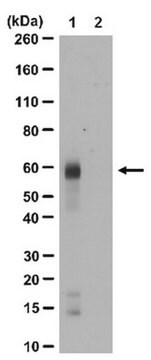ABE26
Anti-acetyl-c-Myc (Lys323) Antibody
from rabbit, purified by affinity chromatography
Synonym(s):
Myc proto-oncogene protein, Class E basic helix-loop-helix protein 39, HLHe39, Proto-oncogene c-Myc, Transcription factor p64, c-MYC
About This Item
Recommended Products
biological source
rabbit
Quality Level
antibody form
affinity isolated antibody
antibody product type
primary antibodies
clone
polyclonal
purified by
affinity chromatography
species reactivity
mouse, human
species reactivity (predicted by homology)
rhesus macaque (based on 100% sequence homology), chimpanzee (based on 100% sequence homology)
technique(s)
western blot: suitable
NCBI accession no.
UniProt accession no.
shipped in
wet ice
target post-translational modification
acetylation (Lys323)
Gene Information
chimpanzee ... Myc(464393)
human ... MYC(4609)
mouse ... Myc(17869)
rhesus monkey ... Myc(694626)
General description
Specificity
Immunogen
Application
Peptide Inhibition Assay Analysis: A representative lot was used by an independent laboratory in HEK293T cells co-transfected with mouse wildtype c-Myc and P300. (Image courtesy of Dr. Ernest Martinez, Department of Biochemistry, University of California at Riverside.)
Epigenetics & Nuclear Function
Transcription Factors
Quality
Western Blot Analysis: 0.2 µg/mL of this antibody detected c-Myc on 10 µg of transfected HEK293T cell lysates.
Target description
Physical form
Storage and Stability
Analysis Note
Transfected HEK293T cell lysates
Other Notes
Disclaimer
Not finding the right product?
Try our Product Selector Tool.
Storage Class Code
12 - Non Combustible Liquids
WGK
WGK 1
Flash Point(F)
Not applicable
Flash Point(C)
Not applicable
Certificates of Analysis (COA)
Search for Certificates of Analysis (COA) by entering the products Lot/Batch Number. Lot and Batch Numbers can be found on a product’s label following the words ‘Lot’ or ‘Batch’.
Already Own This Product?
Find documentation for the products that you have recently purchased in the Document Library.
Our team of scientists has experience in all areas of research including Life Science, Material Science, Chemical Synthesis, Chromatography, Analytical and many others.
Contact Technical Service







